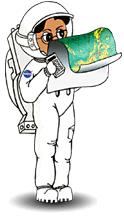![]()
 |
Guess what!Makemake (pronounced mah-kee-mah-kee) is named after the god of fertility in Rapanui mythology. The Rapanui are the native people of Easter Island. Easter Island is located in the southeastern Pacific Ocean, 3600 kilometers off the coast of Chile. |
|
After Eris and Pluto, Makemake is the third largest known dwarf planet. Along with fellow dwarf planets
Pluto and Haumea, Makemake is located in the Kuiper Belt, a region outside the orbit of Neptune. Pluto and
Makemake are the two brightest objects that have so far been discovered in the Kuiper Belt. It takes
310 Earth years for this dwarf planet to make one orbit around the Sun.
Makemake was first observed in 2005 by a team of astronomers led by Michael Brown. Its codename was Easterbunny. It was officially recognized as a dwarf planet by the International Astronomical Union in 2008. Observations have found evidence of frozen nitrogen on Makemake's surface. Frozen ethane and methane have also been detected on the surface. In fact, astronomers believe the methane may actually be present in pellets as large as one centimeter in diameter. Astronomers also found evidence of tholins. Tholins are molecules that form whenever solar ultraviolet light interacts with substances such as ethane and methane. Tholins, if present, usually cause a reddish-brown color. During observations of Makemake, a reddish color was observed. |
|
A QuestionWhat is the possible explanation for the reddish color of Makemake? |
|
| The Facts |
Did you know? |
The Answer |
![]()
| Show me the Level 1 version of this page. |
The StarChild site is a service of the High Energy Astrophysics Science Archive Research Center (HEASARC), within the Astrophysics Science Division (ASD) at NASA/ GSFC.
StarChild Authors: The StarChild Team
StarChild Graphics & Music: Acknowledgments
StarChild Project Leader: Dr. Laura A.
Whitlock
Curator:
Responsible NASA Official: